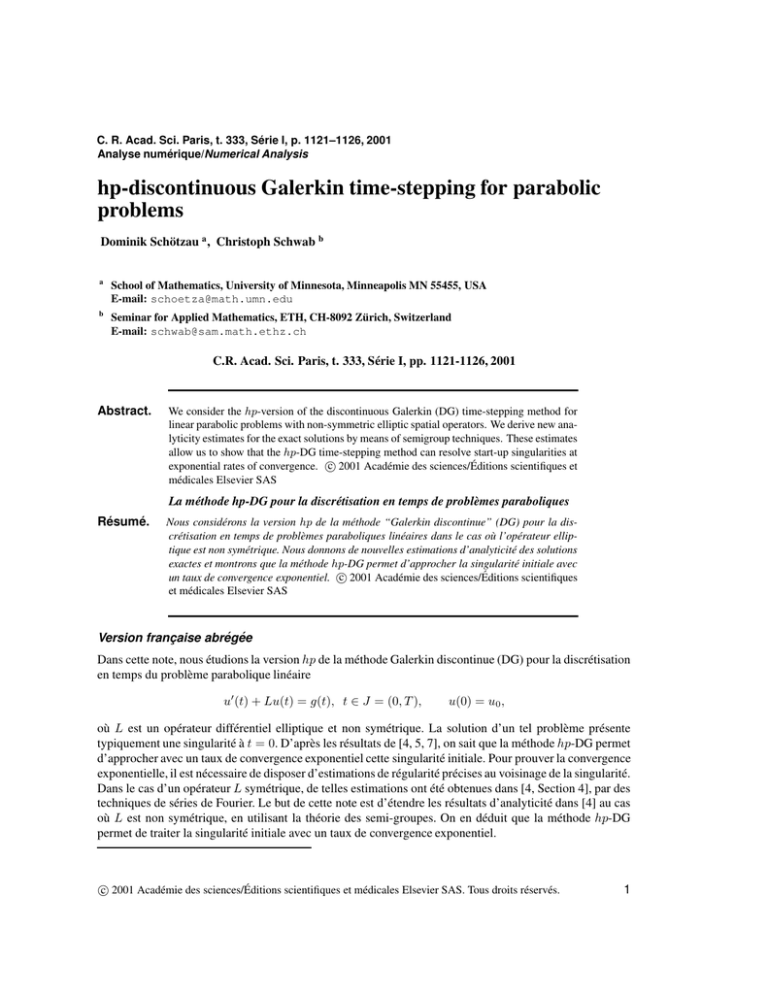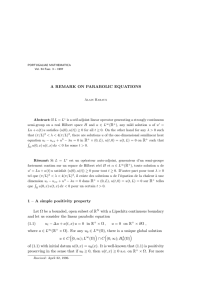hp-discontinuous Galerkin time-stepping for parabolic problems Dominik Sch¨otzau , Christoph Schwab
advertisement

C. R. Acad. Sci. Paris, t. 333, Série I, p. 1121–1126, 2001
Analyse numérique/Numerical Analysis
hp-discontinuous Galerkin time-stepping for parabolic
problems
Dominik Schötzau a , Christoph Schwab b
a
School of Mathematics, University of Minnesota, Minneapolis MN 55455, USA
E-mail: schoetza@math.umn.edu
b
Seminar for Applied Mathematics, ETH, CH-8092 Zürich, Switzerland
E-mail: schwab@sam.math.ethz.ch
C.R. Acad. Sci. Paris, t. 333, Série I, pp. 1121-1126, 2001
Abstract.
We consider the hp-version of the discontinuous Galerkin (DG) time-stepping method for
linear parabolic problems with non-symmetric elliptic spatial operators. We derive new analyticity estimates for the exact solutions by means of semigroup techniques. These estimates
allow us to show that the hp-DG time-stepping method can resolve start-up singularities at
c 2001 Académie des sciences/Éditions scientifiques et
exponential rates of convergence. médicales Elsevier SAS
La méthode hp-DG pour la discrétisation en temps de problèmes paraboliques
Résumé.
Nous considérons la version hp de la méthode “Galerkin discontinue” (DG) pour la discrétisation en temps de problèmes paraboliques linéaires dans le cas où l’opérateur elliptique est non symétrique. Nous donnons de nouvelles estimations d’analyticité des solutions
exactes et montrons que la méthode hp-DG permet d’approcher la singularité initiale avec
c 2001 Académie des sciences/Éditions scientifiques
un taux de convergence exponentiel. et médicales Elsevier SAS
Version française abrégée
Dans cette note, nous étudions la version hp de la méthode Galerkin discontinue (DG) pour la discrétisation
en temps du problème parabolique linéaire
u0 (t) + Lu(t) = g(t), t ∈ J = (0, T ),
u(0) = u0 ,
où L est un opérateur différentiel elliptique et non symétrique. La solution d’un tel problème présente
typiquement une singularité à t = 0. D’après les résultats de [4, 5, 7], on sait que la méthode hp-DG permet
d’approcher avec un taux de convergence exponentiel cette singularité initiale. Pour prouver la convergence
exponentielle, il est nécessaire de disposer d’estimations de régularité précises au voisinage de la singularité.
Dans le cas d’un opérateur L symétrique, de telles estimations ont été obtenues dans [4, Section 4], par des
techniques de séries de Fourier. Le but de cette note est d’étendre les résultats d’analyticité dans [4] au cas
où L est non symétrique, en utilisant la théorie des semi-groupes. On en déduit que la méthode hp-DG
permet de traiter la singularité initiale avec un taux de convergence exponentiel.
c 2001 Académie des sciences/Éditions scientifiques et médicales Elsevier SAS. Tous droits réservés.
1
D. Schötzau, C. Schwab
d
d
Le cadre d’analyse fonctionnelle que nous utilisons repose sur le triplet standard X ,→ H ∼
= H ∗ ,→ X ∗
composé de deux espaces de Hilbert complexes séparables X et H à injection continue dense. On note X ∗
et H ∗ les espaces antiduaux respectifs. On suppose que l’opérateur elliptique L est donné par une forme
sesquilinéaire continue coercive. Pour décrire la régularité de la donnée initiale, on introduit les espaces
intermédiaires Hθ = (H, X)θ,2 et (X ∗ , X)θ,2, 0 6 θ 6 1, définis par la K-méthode d’interpolation.
On observe tout d’abord que l’opérateur −L est le générateur d’un semi-groupe analytique T (t) dans X ∗ ,
cf. Proposition 1 ci-dessous. A l’aide de la représentation intégrale de Dunford-Taylor de T (l) (t), nous
obtenons alors les estimations d’analyticité suivantes, explicites en tous les paramètres pertinents.
T H ÉOR ÈME 1. – Il existe des constantes C > 0, d > 0 telles que
kT (l) (t)k2L(Xθ ,X) 6 Cd2l+1−2θ Γ(2l + 2 − 2θ)t−2(l+1)+2θ
pour tout t > 0, l ∈ N0 et 0 6 θ 6 1.
Suivant la méthode de [4, Section 4], le Théorème 1 fournit une caractérisation complète de la singularité au
voisinage de t = 0. Ce résultat est donné dans le Corollaire 1 ci-dessous et est l’ingrédient le plus essentiel
pour obtenir un taux de convergence exponentiel dans la méthode hp-DG.
Afin de discrétiser en temps le problème parabolique, soit M = {I m = (tm−1 , tm )}M
m=1 une partition
de J = (0, T ) en sous-intervalles. On attribue à chaque intervalle I m un ordre d’approximation rm > 0
et on rassemble ces nombres dans le vecteur r = {rm }M
m=1 . La méthode hp-DG definie ci-dessous dans
l’équation (5) est un schéma implicite discretisé en temps qui fournit une approximation U de la solution
du problème parabolique dans l’espace discret V r (M; X) = {u : J → X : u|Im ∈ P rm (Im ; X), 1 6
m 6 M }. Ici, P rm (Im ; X) est l’espace des polynômes de degré 6 rm à valeurs dans X, definis sur Im . On
PM
définit N = m=1 (rm + 1), nombre de degrés de liberté de la discrétisation en temps. Suivant [4], nous
obtenons des estimations d’erreur pour l’approximation DG qui sont explicites en les paramètres locaux de
discrétisation ainsi qu’en la régularité locale de la solution exacte ; ces estimations d’erreurs sont données
dans la Proposition 3 ci-dessous. Combinées aux estimations de régularité, elles nous permettent de traiter
la singularité au temps t = 0 et d’obtenir un taux de convergence exponentiel.
Soit J = (0, 1) pour simplifier. On considère un raffinement géométrique des pas de temps et des ordres
d’approximation à croissance linéaire avec t0 = 0, tm = σ M −m et rm = bµmc, 1 6 m 6 M , pour un
facteur d’échelle σ ∈ (0, 1) et une pente µ > 0.
T H ÉOR ÈME 2. – On suppose que u0 ∈ Hθ pour 0 < θ 6 1 et que g : J → H est analytique dans J. Soit U
l’approximation DG correspondant à des ordres à croissance linéaire et à des pas de temps géométriques.
Alors il existe une pente µ0 > 0 telle que pour tous les ordres d’approximation à croissance linéaire de
pente µ > µ0 , on ait
1
ku − U kL2 (J;X) 6 C exp(−bN 2 )
pour des constantes C et b indépendantes de N , nombre de degrés de liberté utilisées dans la discrétisation.
Enfin, nous remarquons que ce résultat reste vrai pour une donnée g analytique par morceaux. Dans ce cas,
il est nécessaire d’utiliser aussi un raffinement hp aux points de discontinuité de g.
1. Introduction
In this note, we study the hp-version of the discontinuous Galerkin (DG) time-stepping method for the
linear parabolic problem
u0 (t) + Lu(t) = g(t), t ∈ J = (0, T ),
u(0) = u0 ,
where g is a given source term, u0 an initial datum, and L a non-symmetric elliptic spatial operator.
2
(1)
hp-DG time-stepping for parabolic problems
The solutions to (1) typically are piecewise analytic: they exhibit start-up singularities at t = 0 induced by
incompatible initial data and for t > 0 the mapping t 7→ u(t) is analytic, reflecting the fact that elliptic operators are generators of analytic semigroups [1, 3]. It has been shown in [4, 5, 7] that the hp-version of the
DG time-stepping method can approximate these start-up singularities at exponential rates of convergence
by the use of geometrically refined time steps, accompanied with a linear increase of the approximation orders. One of the main ingredients needed to prove exponential convergence are precise regularity estimates
in the neighborhood of the singularities, which, in turn, rely on precise and explicit estimates of the analyticity properties of the semigroups generated by the elliptic operators. In the case of symmetric operators L
such estimates have been established in [4, Section 4] by Fourier series techniques.
The purpose of this note is to extend the analyticity results in [4] to the case where L is non-symmetric, thus,
also covering the practically relevant cases of convection-diffusion problems or convection-dominated incompressible flow problems. To this end, we use classical semigroup theory and derive analyticity estimates
that are explicit in all the parameters of interest. As a consequence, we prove that the hp-DG time-stepping
method for (1) is able to resolve singularities at exponential convergence.
d
d
The functional analytic framework for (1) is based on a standard triple X ,→ H ∼
= H ∗ ,→ X ∗ of two
complex, separable Hilbert spaces X and H with dense and continuous injection, and with X ∗ and H ∗
denoting their respective antidual spaces. We write (·, ·)H for the inner product in H and (·, ·)X ∗ ×X for
the duality pairing in X ∗ × X. The linear elliptic operator L ∈ L(X, X ∗ ) is assumed to be given by
(Lu, v)X ∗ ×X = a(u, v), u, v ∈ X, where a : X × X → C is a continuous and coercive sesquilinear form
with
|a(u, v)| 6 αkukX kvkX , u, v ∈ X,
Re a(u, u) > βkuk2X ,
u ∈ X.
(2)
For u0 ∈ H and g ∈ L2 (J; H), there is a unique solution u ∈ L2 (J; X) ∩ H 1 (J; X ∗ ), see [2]. To describe
the smoothness of the initial values we introduce spaces between H and X defined by the K-method of
interpolation as Hθ = (H, X)θ,2 , 0 6 θ 6 1 (with the usual convention that H0 = H and H1 = X).
Further, we denote by Xθ , 0 6 θ 6 1, the interpolation space (X ∗ , X)θ,2 between X ∗ and X. From [2,
Prop. I.2.1] and the reiteration theorem of interpolation theory we have that H θ = X 1 + θ for θ ∈ (0, 1).
2
2
2. Time-analyticity of solutions
In this section, we investigate the analyticity properties of solutions to (1) and present our main results.
Throughout, we will apply the theory of semigroups as presented in [1, 3].
d
P ROPOSITION 1. – The operator −L : X ,→ X ∗ → X ∗ is the infinitesimal generator of an analytic
semigroup T (t) in X ∗ , the resolvent set ρ(−L) of −L contains
Σ(δ, V ) = {λ ∈ C : | arg λ| <
π
+ δ} ∪ V
2
for some constant 0 < δ < π/2 and some neighborhood V of zero (only depending on α and β). Further,
there exists a constant M > 0 (only depending on α and β) such that
k(λI + L)−1 kL(X ∗ ,X) + (1 + |λ|)k(λI + L)−1 kL(X ∗ ,X ∗ ) 6 M
for all λ ∈ Σ(δ, V ).
Proof . – Obviously, L is a densely defined and closed operator in X ∗ . Using the coercivity and continuity
properties (2), we have for λ ∈ C with Re λ > 0,
k(λI + L)−1 kL(X ∗ ,X ∗ ) 6
1 α
( + 1).
|λ| β
Since L is an isomorphism, we also have 0 ∈ ρ(−L). Theorem II.5.2 in [3] then guarantees the existence
of constants 0 < δ < π/2 and M 0 > 0 such that ρ(−L) ⊃ Σδ = {λ ∈ C : | arg λ| < π/2 + δ} ∪ {0}
3
D. Schötzau, C. Schwab
0
and k(λI + L)−1 kL(X ∗ ,X ∗ ) 6 M
|λ| for λ ∈ Σδ , λ 6= 0. Hence, it follows from [3, Theorem I.7.7 and
Theorem II.5.2] that −L is the infinitesimal generator of an analytic semigroup T (t) in X ∗ . Moreover,
since 0 ∈ ρ(−L), there is a neighborhood V of zero in ρ(−L). Thus, there exists a constant M 1 > 0
(depending on M 0 and V ) such that
k(λI + L)−1 kL(X ∗ ,X ∗ ) 6
M1
1 + |λ|
for λ ∈ Σ(δ, V ) = Σδ ∪ V . Finally, for λ ∈ Σ(δ, V ) and x ∈ X we write x = L−1 ((λI + L)x − λx) and
obtain easily that kxkX 6 M2 k(λI + L)xkX ∗ , giving rise to k(λI + L)−1 kL(X ∗ ,X) 6 M2 , for a constant
M2 > 0. Setting M = max{M1 , M2 } finishes the proof.
Our main result is the following estimate for the analytic semigroup T (t) generated by −L. For symmetric
operators L and θ ∈ [ 12 , 1], the same result has been established in [4, Proposition 4.2] by means of Fourier
series techniques. We also remark that results of this type have been known, see, e.g., [1, 6]. However,
the explicit dependence of the estimates on l, t and θ is crucial in the convergence analysis of hp-DG
time-stepping.
T HEOREM 1. – There are positive constants C and d (only depending on α and β) such that
kT (l) (t)k2L(Xθ ,X) 6 Cd2l+1−2θ Γ(2l + 2 − 2θ)t−2(l+1)+2θ
for t > 0, l ∈ N0 and 0 6 θ 6 1.
Proof . – We first show that
kT (l) (t)kL(X ∗ ,X) 6 Cdl+1 Γ(l + 1)t−(l+1) ,
(3)
t > 0, l ∈ N0 .
To this end, fix t > 0 and l ∈ N0 . Using the Dunford-Taylor integral representation of T (t) and its
derivatives [3, Theorem I.7.7], we can write
Z
1
λl etλ (λI + L)−1 dλ,
T (l) (t) =
2πi Γ
where Γ is a piecewise smooth path running in the resolvent set of −L from ∞ · e −iδ to ∞ · eiδ for some
δ ∈ (π/2, π). Choosing Γ = Γ1 ∪ Γ2 ∪ Γ3 with
Γ1 = {se−iδ : ∞ > s > t−1 },
we obtain
T
(l)
(t) =
Γ2 = {t−1 eis : −δ 6 s 6 δ},
Γ3 = {seiδ : t−1 6 s < ∞},
Z ∞
1
sl ets cos(δ) eiδl+ist sin(δ)+iδ (seiδ I + L)−1 ds
2πi t−1
Z ∞
1
sl ets cos(δ) e−iδl−ist sin(δ)−iδ (se−iδ I + L)−1 ds
−
2πi t−1
Z δ
1
1
is
+
t−l ecos(s) eils+i sin(s) ( eis I + L)−1 ds.
2πi −δ
t
t
The resolvent estimate in Proposition 1 then gives
Z
Z
M ∞ l ts cos(δ)
M δ −l cos(s) s
t e
kT (l) (t)kL(X ∗ ,X) 6
se
ds +
ds
π t−1
2π −δ
t
Z
Z ∞
τ l e−τ dτ + Ct−(l+1)
6 Ct−(l+1) | cos(δ)|−(l+1)
6 Ct−(l+1) c(δ)−(l+1)
4
Z
| cos(δ)|
∞
0
δ
ecos(s) sds
−δ
τ l e−τ dτ + t−(l+1) K(δ) 6 Ct−(l+1) dl+1 Γ(l + 1).
hp-DG time-stepping for parabolic problems
Here, we substituted τ = ts| cos(δ)| in the first integral and used the definition of the Gamma function.
This proves (3). Next, we claim that
kT (l) (t)kL(X,X) 6 C3 dl Γ(l)t−l ,
(4)
t > 0, l ∈ N0 .
Consider first l = 0. Since (−L)T (t)x = T (t)(−L)x for x ∈ X, T (t) is uniformly bounded in X ∗ and L
is an isomorphism, we have
kT (t)xkX = kL−1 LT (t)xkX = kL−1 T (t)LxkX 6 CkxkX .
Thus, kT (t)kL(X,X) 6 C for t > 0. Moreover, for l > 1,
kT (l) (t)xkX = k(−L)l T (t)xkX = k(−L)l−1 T (t)(−L)xkX 6 kT (l−1)(t)kL(X ∗ ,X) kLxkX ,
and we obtain (4) with (3).
The assertion of the theorem then follows from (3)–(4) by interpolating between X and X ∗ and standard
properties of the Gamma function.
Using Duhamel’s representation formula, see [1, Proposition III.1.3.1],
Z t
T (t − s)g(s)ds,
0 6 t 6 T,
u(t) = T (t)u0 +
0
we proceed as in [4, Section 4] and obtain from Theorem 1 immediately the following characterization
of start-up singularities which is completely explicit in the parameters of interest. This result is the key
ingredient to prove exponential rates of convergence in the hp-DG time-stepping method.
C OROLLARY 1. – Let u0 ∈ Hθ for 0 6 θ 6 1 and let g : J → H be analytic in J. Then the solution u
of (1) is analytic away from t = 0 and satisfies
ku(l) (t)k2X 6 Cd2l Γ(2l + 2)t−(2l+1)+θ ,
l ∈ N0
in a neighborhood of t = 0, with C and d solely depending on u 0 , g, α and β.
3. The hp-version DG time-stepping method
Let M = {Im = (tm−1 , tm )}M
m=1 be a partition of J = (0, T ) into subintervals. We set k m = tm − tm−1
and define the one-sided limits in H or X of a (piecewise sufficiently smooth) function u by
u+
m =
lim
s→0, s>0
u(tm + s),
0 6 m 6 M − 1,
u−
m =
lim
s→0, s>0
u(tm − s),
1 6 m 6 M.
−
Furthermore, we set [u]m = u+
m − um for 1 6 m 6 M − 1. We assign to each time interval I m an
approximation order rm > 0, collect these orders in the vector r = {rm }M
m=1 , and define the discrete space
V r (M; X) = {u : J → X : u|Im ∈ P rm (Im ; X), 1 6 m 6 M },
where P rm (Im ; X) denotes the polynomials of degree 6 rm on Im with coefficients in X. We set N =
PM
m=1 (rm + 1) for the number of degrees of freedom of the time discretization. Introducing the form B
and the functional F given by
B(U, V ) =
M Z
X
m=1
((U 0 , V )X ∗ ×X + a(U, V ))dt +
Im
F (V ) = (u0 , V0+ )H +
M Z
X
m=1
M
X
+
([U ]m−1 , Vm−1
)H + (U0+ , V0+ )H ,
m=2
(g(t), V )X ∗ ×X dt,
Im
5
D. Schötzau, C. Schwab
the DG time-stepping method for (1) reads as follows: find U ∈ V r (M; X) such that
B(U, V ) = F (V )
for all V ∈ V r (M; X).
(5)
Note that this method can be interpreted as an implicit time-stepping scheme, owing to the discontinuous
nature of V r (M; X): the DG method amounts to the solution of an elliptic spatial system of size r m + 1 in
time step Im . Using the decoupling method (i) in [4, Section 6] and [4, Lemma 6.6], it is easy to show that
this system has a unique solution in each time step and hence the DG approximation U is well defined.
The following error estimate from [4] immediately generalizes to the non-symmetric setting in this note.
P ROPOSITION 3. – Let U be the DG approximation in V r (M; X). Then:
ku − U k2L2 (J;X) 6 C
M
X
km 2(sm +1)
Γ(rm + 1 − sm )
(
)
max{1, rm }−2
kuk2H sm +1 (Im ;X)
2
Γ(r
+
1
+
s
)
m
m
m=1
for any 0 6 sm 6 min{rm , s0,m }, s0,m ∈ N0 . The constant C > 0 is independent of M , sm , km and rm .
The above estimates are explicit in the local discretization parameters, as well as in the local regularity of
the exact solution. Combining Proposition 3 with the regularity estimates in Corollary 1 allows us to prove
that start-up singularities at t = 0 can be resolved exponentially fast.
Let J = (0, 1) for simplicity. We consider geometrically refined time steps and linearly increasing degree
vectors r where t0 = 0, tm = σ M −m and rm = bµmc for 1 6 m 6 M , for a geometric grading factor
σ ∈ (0, 1) and a slope µ > 0.
T HEOREM 2. – Assume u0 ∈ Hθ for 0 < θ 6 1 and g : J → H to be analytic in J. Let U be the DG
approximation of (1) obtained with a linearly increasing approximation degree vector r on geometrically
refined time steps. Then there exists a slope µ0 > 0 such that for all degree vectors with slope µ > µ0 we
have
1
ku − U kL2 (J;X) 6 C exp(−bN 2 ),
with constants C and b independent of N , the number of degrees of freedom used for the time discretization.
Remark 1. – The convergence result in Theorem 2 holds true for source terms g that are piecewise analytic.
In this case, an hp-refinement near the discontinuities of g has to be employed as well, cf. [4].
Finally, we note that in a fully discrete setting the operator L has to be discretized as well and N elliptic
spatial problems have to be solved, cf. [4, 7]. However, the numerical results in [7] indicate that the number
of time degrees of freedom N that are used to reach a certain relative error is an admissible estimate for
the computational cost of the DG time-stepping and that, for problems with start-up singularities, the hpapproach results in a saving of orders of magnitude of CPU time as compared to an h-version approach.
Acknowledgements. The authors thank Elisabeth Logak for her help with the abridged French version.
6
hp-DG time-stepping for parabolic problems
References
[1] H. Amann, Linear and Quasilinear Parabolic Problems, Volume I: Abstract Linear Theory, Monographs in Mathematics, vol. 89, Birkhäuser, Basel, 1995.
[2] J.L. Lions and E. Magenes, Nonhomogeneous Boundary Value Problems and Applications, Springer, Berlin, 1972.
[3] A. Pazy, Semigroups of Linear Operators and Applications to Partial Differential Equations, Applied Mathematical Sciences, vol. 44, Springer, New York, 1983.
[4] D. Schötzau and C. Schwab, Time discretization of parabolic problems by the hp-version of the discontinuous
Galerkin finite element method, SIAM J. Numer. Anal. 38 (2000), 837–875.
[5] D. Schötzau and C. Schwab, An hp a-priori error analysis of the DG time-stepping method for initial value
problems, Calcolo 37 (2000), 207–232.
[6] V. Thomée: Galerkin Finite Element Methods for Parabolic Problems, Springer, New York, 1997.
[7] T. Werder, K. Gerdes, D. Schötzau and C. Schwab, hp-discontinuous Galerkin time-stepping for parabolic problems, Comput. Methods Appl. Mech. Engrg. 190 (49-50) (2001), 6685-6708.
7





